Maasai Chess
The full name of this game is: ZANZIBAR-XXL.
Zanzibar, a big island of Tanzania, is the place of an old sultanate with a rich history. A name that evokes a link with the Arab civilization when their boats were trading all along the coast of East Africa from the Red Sea to Madagascar.
The idea driving the elaboration of Zanzibar was to fill the void squares of the Metamachy lineup. The board is the dozenal 12x12 square battlefield, like for Metamachy. The pieces from Metamachy are used here again, with a small and necessary difference for what concerns the Pawns and the Princes, which is explained below.
In order to decide which pieces to add, the following principles have been observed:
-
Add pieces with medium power. Introducing new high power pieces is always tempting but too many of them really spoils the game.
-
Add pieces which present a strong link with pieces existing in historical chess-variants.
-
Avoid complex moves, especially the compound moves such as pieces that moves as two or more standard pieces. On the opposite, favor moves that give a recognizable personality to the pieces.
-
Complement as much as possible the pieces already used in Metamachy, for instance looking for orthogonal counterparts of diagonal pieces and vice-versa.
The setup occupies four full ranks for each player, which gives 48 pieces in each side. There are 20 different types of pieces.
Each player has: 1 King, 1 Queen, 1 Eagle, 1 Lion, 1 Rhinoceros, 1 Buffalo, 1 Sorceress, 1 Duchess, 2 Princes, 2 Bishops, 2 Knights, 2 Camels, 2 Rooks, 2 Cannons, 2 Elephants, 2 Giraffes, 2 Archers, 2 Machines, 8 Soldiers and 12 Pawns.
Like for Metamachy, there is a choice of different starting setups. Here, that choice is colossal with more than 10,000 possibilities. Black chooses the setup and White makes the first move.
The smaller versions, Zanzibar-S and Zanzibar-XL, were elaborated during the creation of Zanzibar-XXL.
You can play Zanzibar-XXL with Game Courier here!
Setup
At the beginning Pawns, Soldiers and all pieces which come as pairs (Elephants, Cannons, Rooks, Camels, Knights, Giraffes, Bishops, Crocodiles, Princes, Machines) are placed on the board as follows for each player:
- 1st row: Cannon / Camel / Giraffe / Archer / . / . / . / . / Archer / Giraffe / Camel / Cannon
- 2nd row: Elephant / Rook / Knight / Bishop / . / . / . / . / Bishop / Knight / Rook / Elephant
- 3rd row: 4 x Soldiers / Prince / Machine / Machine / Prince / 4 x Soldiers
- 4th row: 12 x Pawns
This is the starting position of the fixed pieces:
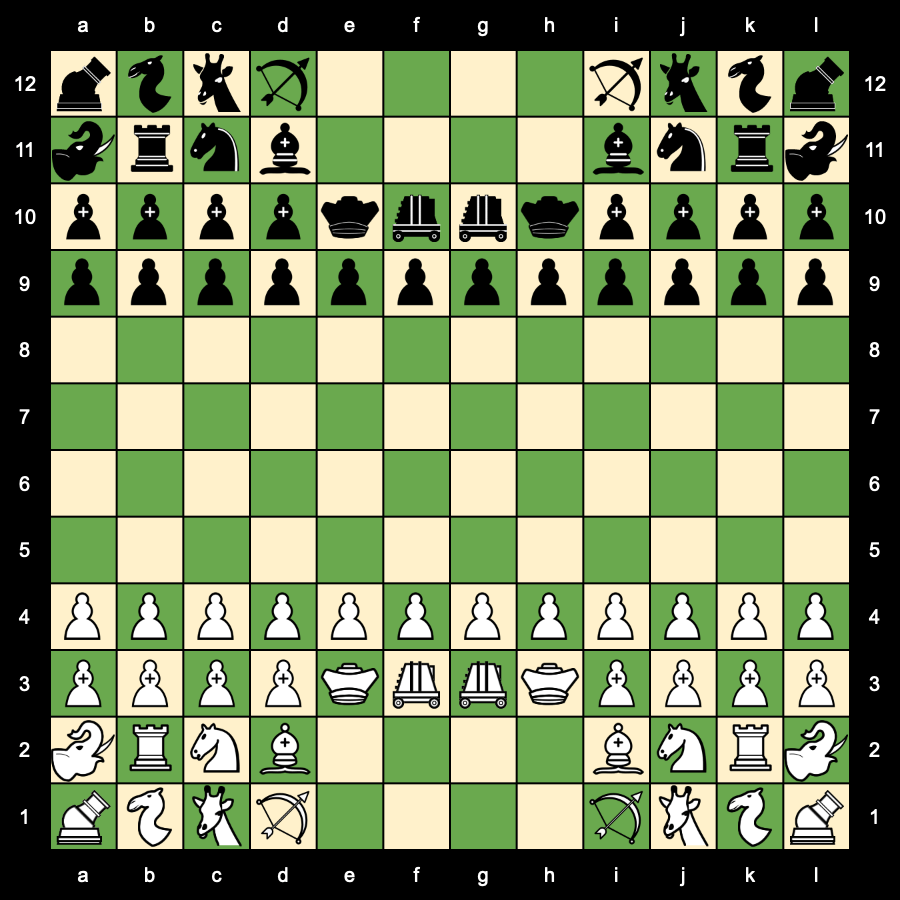
Then, Black freely decides where to place his King on one central square of the first or second row, f12, g12, f11 or g11, then his 7 "single" pieces, Queen - Eagle - Lion - Rhinoceros - Buffalo - Duchess - Sorceress on the remaining free 7 squares on the center of the board (e11, f11, g11, h11, e12, f12, g12, h12) in whichever order.
Then, White put his pieces symmetrically in mirror (if Black King is on f11, White King goes on f2) and makes the first move.
It can be demonstrated that it exists more than 10,000 different starting positions:
- Black King can placed on f11 or 12, the a choice of 2 positions.
- Then, the Queen has a choice of 7 positions on the first or second row.
- Then, the Eagle has a choice of 6 remaining positions
- The Lion has a choice of 5 remaining positions
- The Rhinoceros has a choice of 4 positions
- The Buffalo has a choice of 3 positions
- The Duchess has a choice of 2 positions
- The Sorceress goes on the last remaining free square on the first row.
- 2x7x6x5x4x3x2 = 10080
All positions where the Black King is placed on f12 or g11 are completely equivalent by symmetry and are, therefore, not accounted for.
This is one of the 144 possible starting positions:
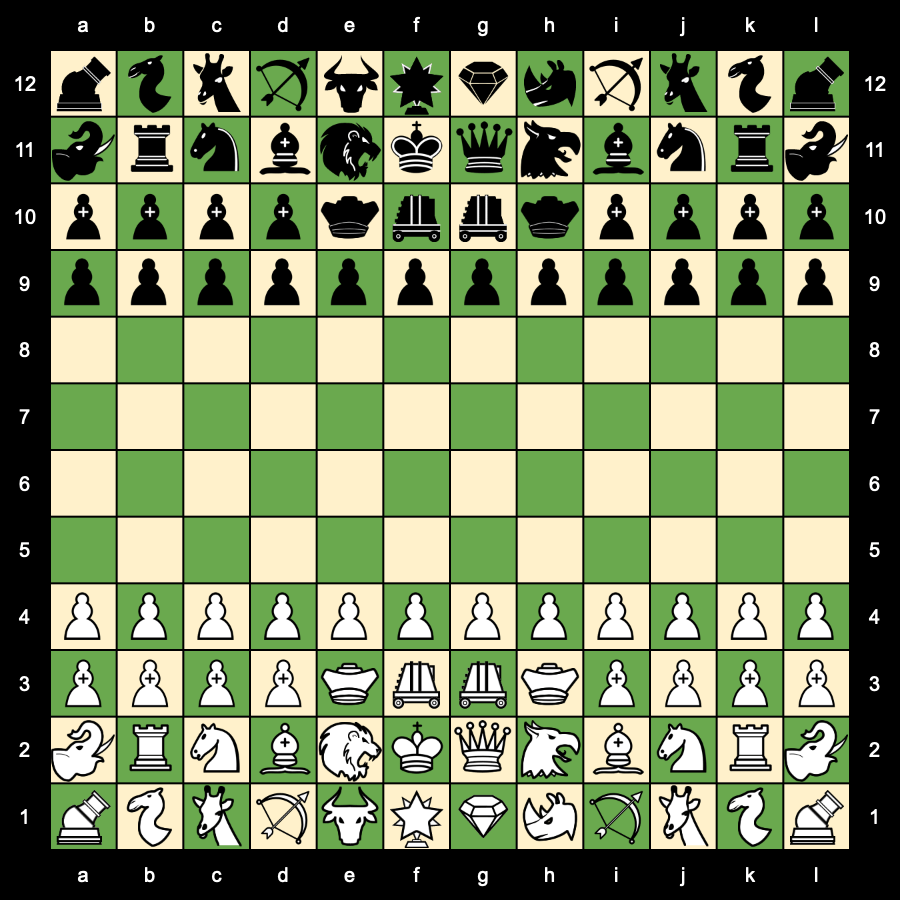
Diagrams made with the fantastic Chess Board Painting Tools provided by Musketeer Chess
Pieces
King: moves 1 step in every (8) directions on a not attacked square. The King is in check if it is attacked by one or several enemy pieces. It is forbidden to play a move letting his King in check.
There is no castling in Zanziba-XXL. At his first move, the King may jump to a free square at two squares' distance. For instance, from f2, it can jump to d1, d2, d3, d4, e4, f4, g4, h4, h3, h2 or h1). It does not matter if the square jumped over is occupied or not; however, the jump is forbidden if that intermediate square is threatened by an enemy piece. When jumping like a Knight, at least one of the two intermediate squares must be free of threat (e.g., if jumping from f2 to h3, either g2 or g3 must not be under attack). The King's jump is not permitted if the King is in check. This rule, which was once prevalent in medieval European chess, replaces castling. Identical to Metamachy.
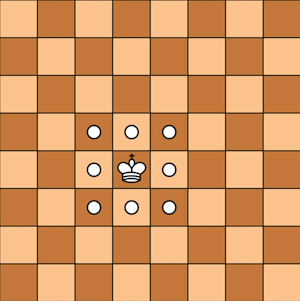
Queen: slides to any square along the file, the rank or a diagonal on which it stands. Identical to standard chess.
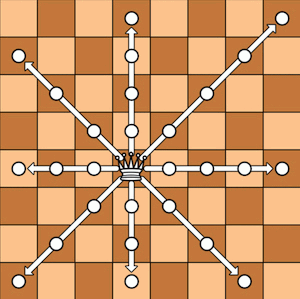
Rook: moves to any square along the file or the rank on which it stands. Identical to standard chess (except there is no castling)
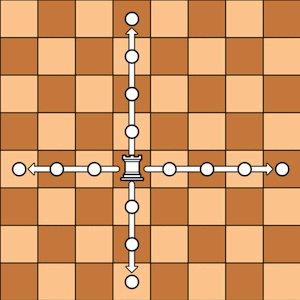
Bishop: slides to any square along a diagonal on which it stands. Identical to standard chess
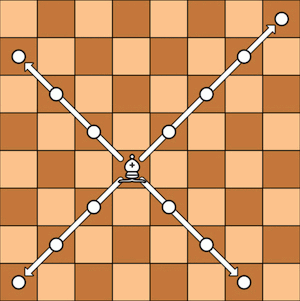
Knight: a (2,1) jumper, it jumps to the opposite square of a 2x3 rectangle. No matter what the intermediate square contains. Identical to standard chess

Pawn: it can move straight forward one, or two square from its starting position on the board, without capturing. It captures one square diagonally forward. Identical to standard chess and different from Metamachy.

Soldier: it moves as a super-Pawn. It captures 1-square diagonally forward like a Pawn, but moves with no capture either 1-square forward or sideways (left or right). It can also step two empty squares forward from any position on the board. Otherwise, it is identical to the Pawn (same promotion, en-passant capture rules). The first recorded author to have used it is Hirsch Silberschmidt in his “Kriegspiel” chess variant published in 1826.
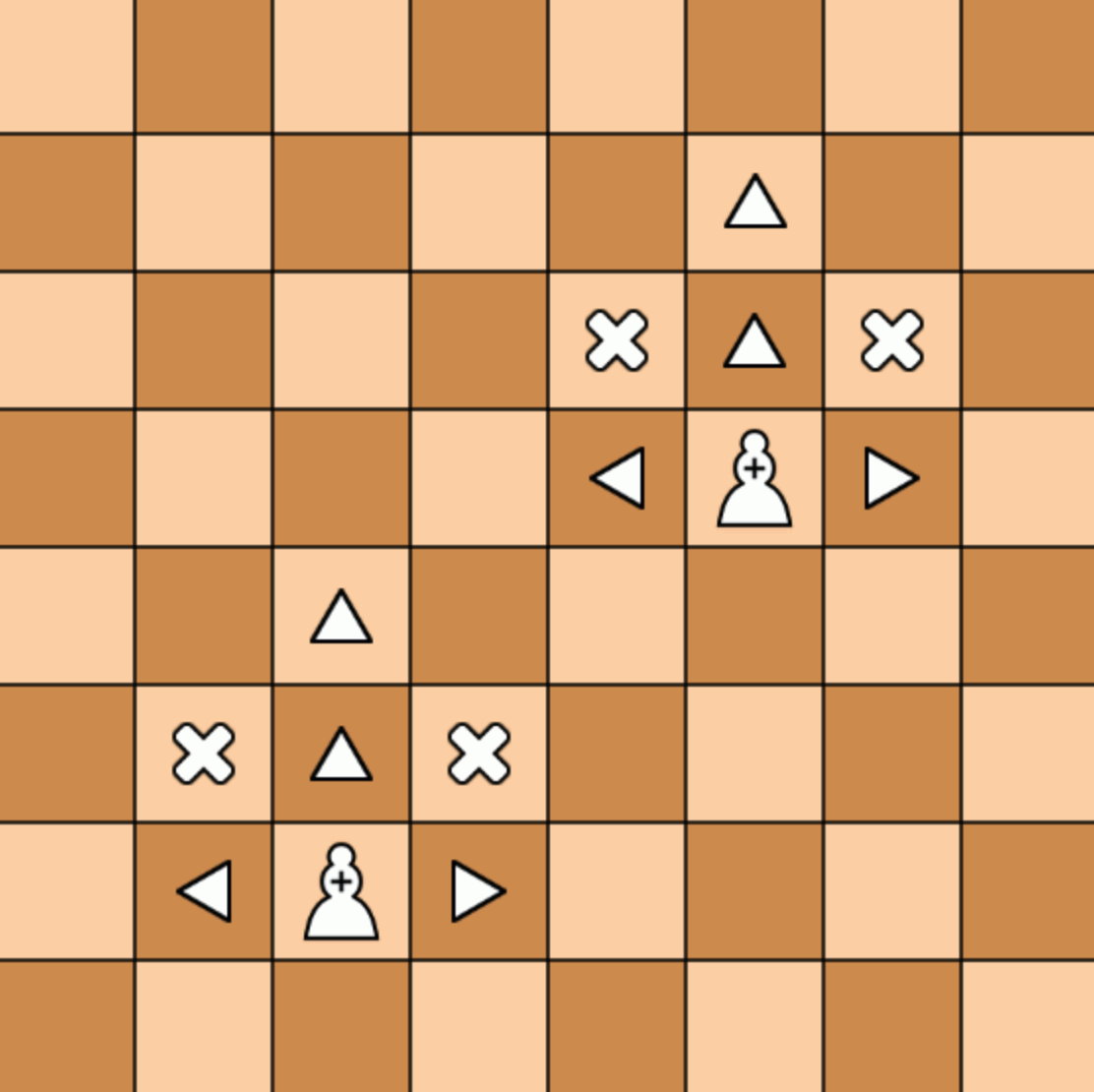
Eagle: moves one square diagonally and then, slides away of an indefinite number of squares vertically or horizontally. It is authorized to go only one square diagonal. It can not jump and the unobstructed path must start with the diagonal movement. This piece is almost as powerful as the Queen and is inspired by the Giraffe from Tamerlane's Chess and the Aanca (a mythical giant bird preying elephants, mistaken for a gryphon) from Alfonso X's Grande Acedrex. Identical to Metamachy.
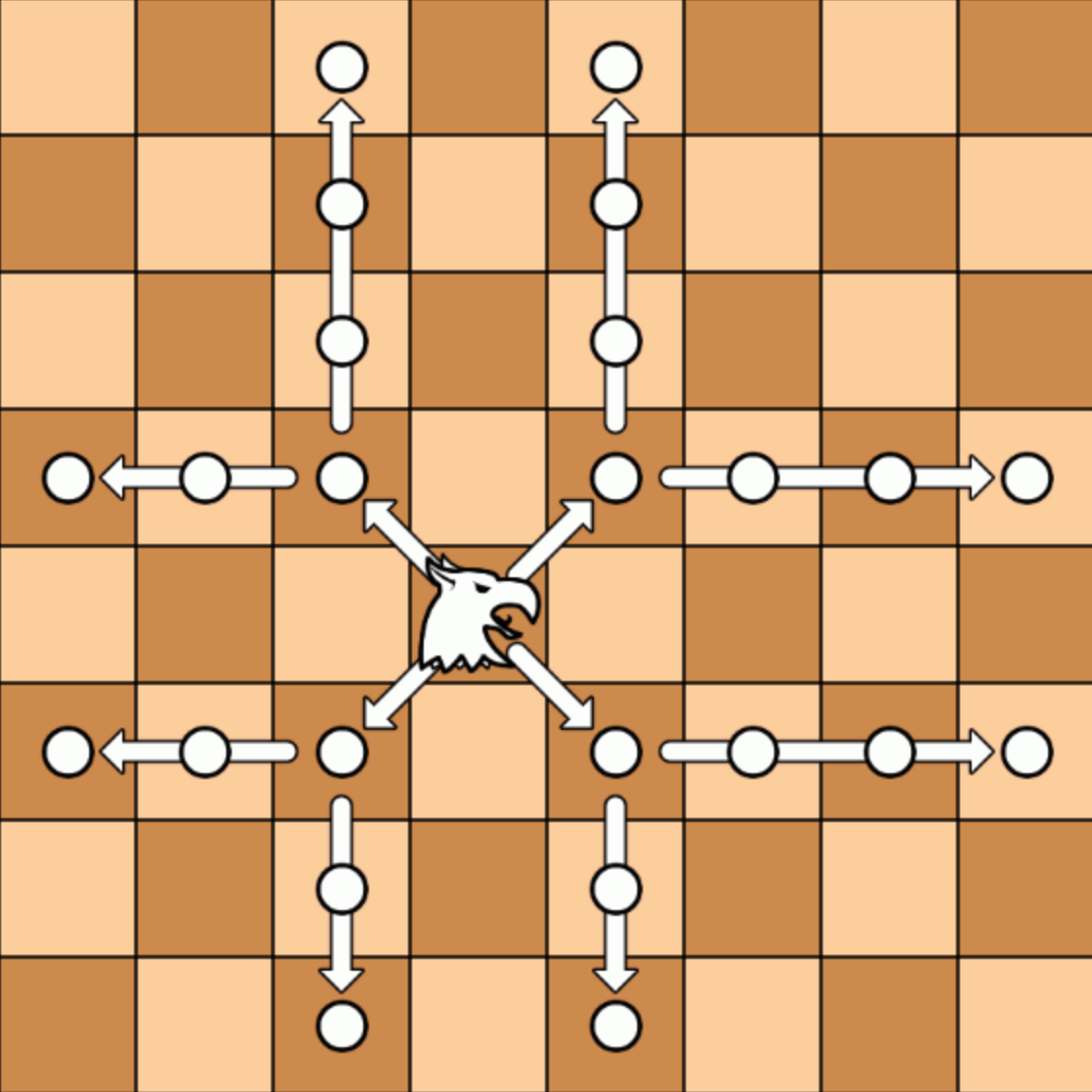
Rhinoceros: moves one square vertically or horizontally and then, slides away of an indefinite number of squares diagonally. It is authorized to go only one square in line or column. It can not jump and the unobstructed path must start with the orthogonal movement. This piece is inspired by the Unicorn of medieval Grande Acedrex. It is a counterpart of the Eagle. It is now called Manticore on the chessvariants pages. Identical to Zanzibar.
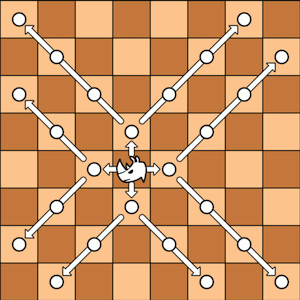
Lion: moves as a King (a single step move in any direction as Wazir or Ferz), or may jump to a position two squares away, jumping in any orthogonal (Dabbaba) or diagonal (Alfil) directions, or jumping as a Knight. (Inspired by Chu Shogi, the most popular variant of the Japanese Chess, where the Lion has the same range but is more dreadful as it can move twice in a turn). Identical to Metamachy.

Camel: a (3,1) jumper, it jumps to the opposite square of a 2x4 rectangle, like an extended Knight. No matter what intermediate squares contain. Note that it always stays on the same color of square. A well known piece from medieval Muslim great Chess like Tamerlane's Chess. Identical to Metamachy

Giraffe: a (3,2) jumper, it jumps to the opposite square of a 3x4 rectangle, like an extended Knight. No matter what intermediate squares contain. Note that it always changes the same color of its square. That piece is found in Alfonso X's Grant Acedrex (but its move has been rendered differently by 20th century historians). The same pattern, but with a non-jumping move, is found in Janggi, Korean Chess, for the Elephant. Under the name of Zebra, it is also a fairy piece used by problemists for compositions. Identical to Zanzibar.
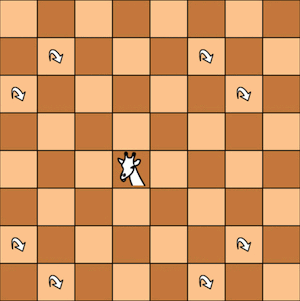
Buffalo: combines the leaps of the Knight (2,1), the Camel (3,1) and the Giraffe (3,2). Identical to Zanzibar.
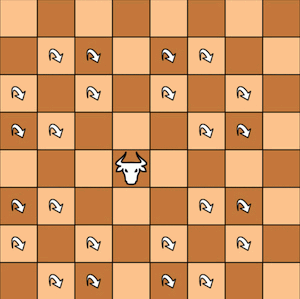
Cannon: exactly as in Xiangqi. The Cannon moves without taking like a Rook, but it takes by going in a straight horizontal and vertical line and jumping over exactly one piece. When a Cannon takes a piece, there must be exactly one piece between the original and final square of the Cannon's move - this piece may be of either color. This is identical to the move of the Cannon in Shako and Metamachy.
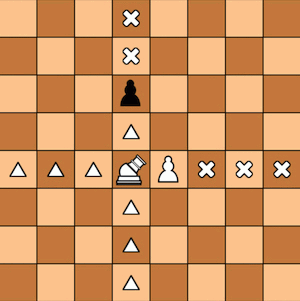
Archer: it is the diagonal counterpart of the Xiangqi's Cannon. It moves like a Bishop and needs an intermediate piece between itself and its victim to capture it. The Archer jumps the intermediate and takes the victim on its square. The intermediate is left unaffected. Previously named Crocodile. Also known as Vao by problemists. Identical to Zanzibar.
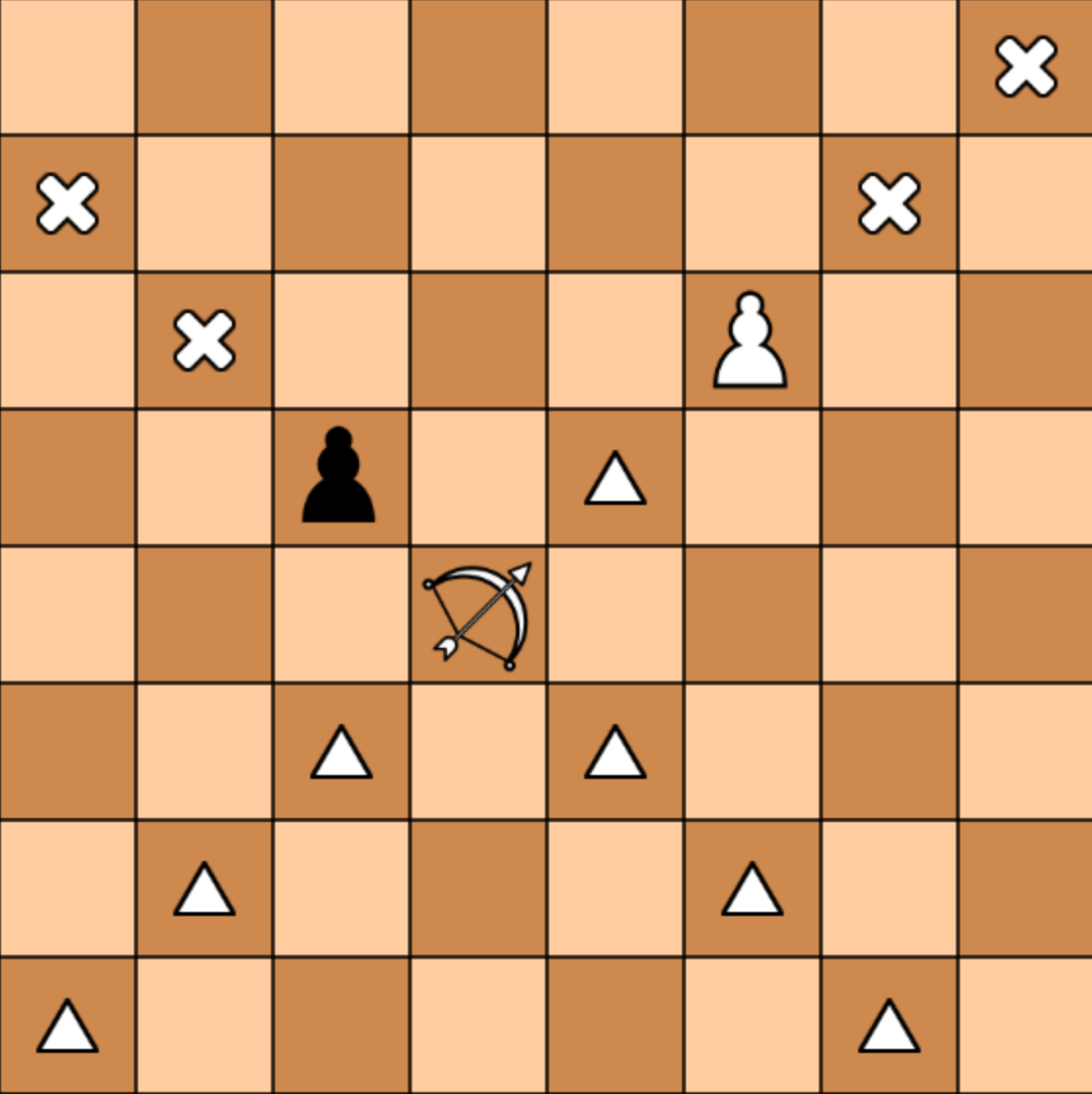
Machine: it is an orthogonal counterpart of the Elephant as it moves 1 or 2 squares orthogonally, jumping over the first square if it is occupied. Then, it combines the moves of old Dabbaba and Wazir found in ancient Muslim Chess variants. The word Dabbaba designated a siege machine at war in Arabic, hence the name given for this piece. Identical to Zanzibar.
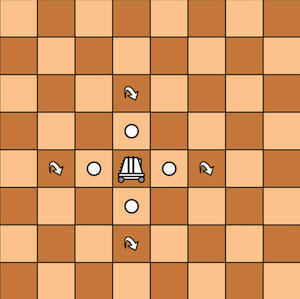
Elephant: exactly as in Shako and Metamachy. It moves one or two squares diagonally. When an Elephant moves two squares, no matter what intermediate squares contain. Note that it always stays on the same color of square. The Elephant moves as the combined Alfil and Ferz from Shatranj, two pieces which were also present in mediaeval Chess and have disappeared with the birth of modern moves for the Bishop and the Queen.

Prince: a non-royal King who moves and captures one square in any direction, but without being hindered by check. It has been inspired by medieval games like the Courier chess , an old chess variant, played in Germany, where it is called "Man". Like the Soldier, he can also move, without jumping, to a second empty square straight ahead from any position on the board.
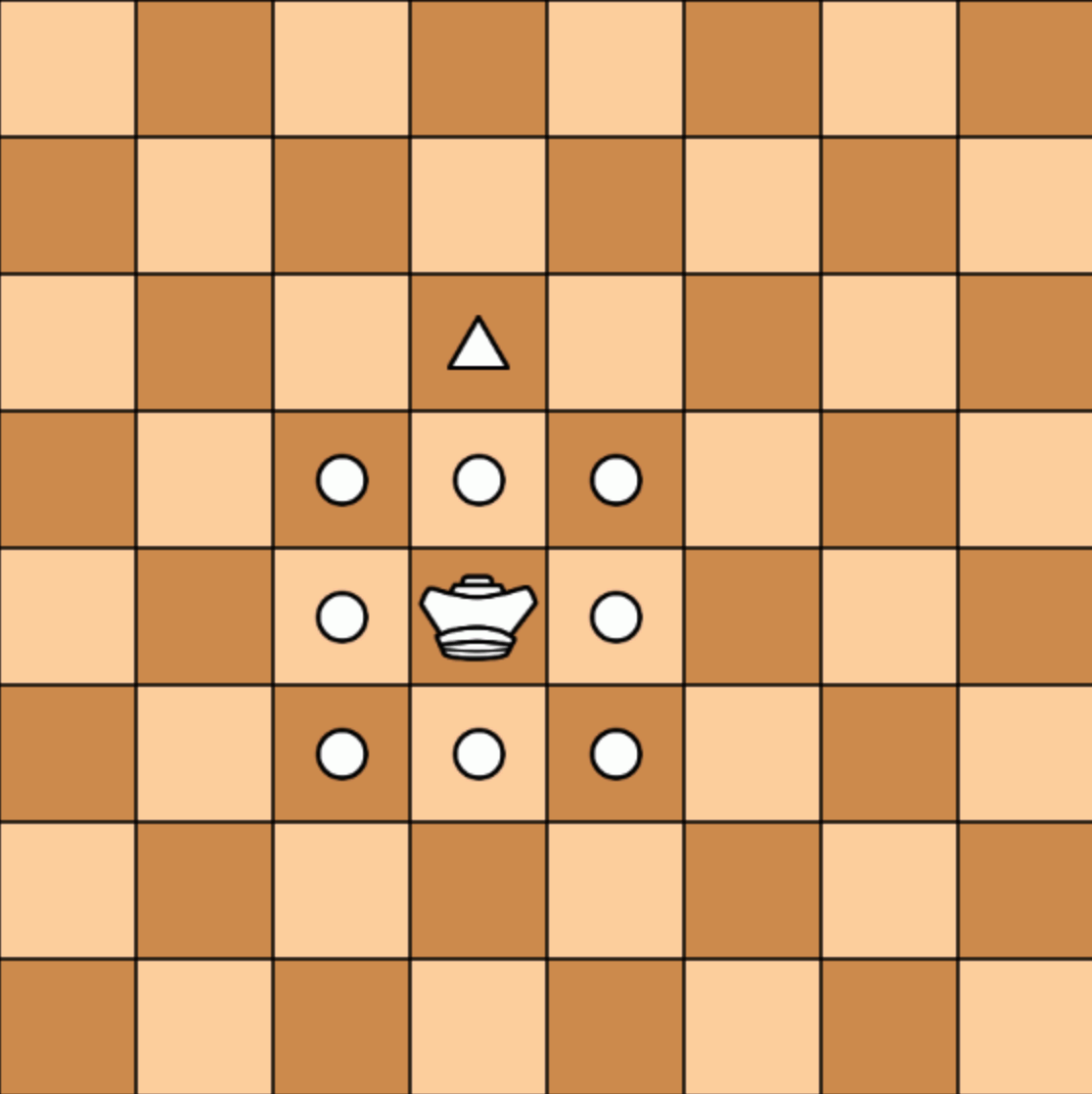
Sorceress: it moves like a Queen and needs an intermediate piece between itself and its victim to capture it. The Sorceress jumps the intermediate and takes the victim on its square. The intermediate is left unaffected. Like the Queen is Bishop + Rook, the Sorceress is Cannon + Archer. Identical to Terachess-II
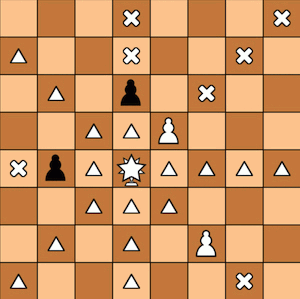
Duchess: it moves as a limited Queen, one, two or three squares in any straight directions. When moving two or three squares, it may jump and it does not matter what any intermediate squares contain. Identical to Terachess-II
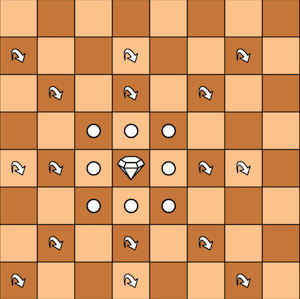
Rules
The goal is to checkmate the opposing King.
Pawn, Soldier and Prince Promotion: A Pawn, a Soldier or a Prince reaching the last rank of the board is immediately replaced by a "chief" piece: Queen, Eagle, Lion, Sorceress, Duchess, Rhinoceros or Buffalo. Promotion to any other type of piece is not allowed. It is permitted to promote a Pawn, a Soldier or Prince to a type of piece already present on the same side; however; it is considered "good etiquette" to avoid choosing a piece which is not captured yet, if possible.
En Passant capture: Any time a Pawn, a Soldier or a Prince takes a double step and passes through the capture square of an opposing Pawn or Soldier, that Pawn or Soldier may capture the opposing piece as if it had only moved one square. This en passant capture must be made in the immediate move following the double step. Only Pawns and Soldiers may capture en passant.
End Of Game: The end-of-game rules, checkmate, stalemate, etc., are identical to standard chess.
Notes
Pieces Value are estimated as follows, normalized to 5 for the Rook :
Lion (10.25), Queen (10), Duchess (9.75), Buffalo (9), Eagle (8.25), Rhinoceros (7.5), Sorceress (6.5), Rook (5), Bishop (3.75), Cannon (3.5), Prince (3.5), Machine (3.25), Knight (2.75), Elephant (2.75), Archer (2.5), Camel (2.5), Giraffe (2.25), Soldier (1.1), Pawn (0.8).
Deep thanks to H.G. Muller for making the Interactive Diagram below
 This 'user submitted' page is a collaboration between the posting user and the Chess Variant Pages. Registered contributors to the Chess Variant Pages have the ability to post their own works, subject to review and editing by the Chess Variant Pages Editorial Staff.
This 'user submitted' page is a collaboration between the posting user and the Chess Variant Pages. Registered contributors to the Chess Variant Pages have the ability to post their own works, subject to review and editing by the Chess Variant Pages Editorial Staff.
By Jean-Louis Cazaux.
Last revised by Jean-Louis Cazaux.
Web page created: 2021-05-06. Web page last updated: 2022-11-30
